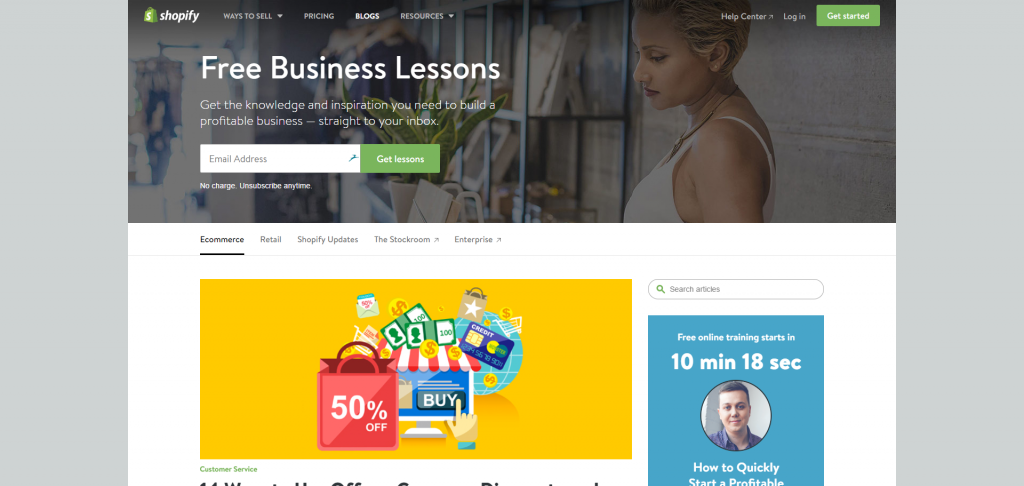
Guest blogger Patrick Foster gives some practical ideas about learning from your competition.
Did you know that 67% of leads in 2016 were generated from brand blogs? Or that 63% of B2B marketers say that their most effective content is infographics? Without statistics and evidence from competitor research at your fingertips, it can be difficult to navigate the choppy waters of content marketing for your online business. Let us guide you through what you could learn and put into action by examining what tactics others in your vertical use to convince and convert.
For general inspiration on ways to revamp your online marketing, check out our previous post.
Cherry pick from competitor content with BuzzSumo
 Your competitors can teach you a lot about the way you should approach your content marketing. If they are a bigger business than yourself, chances are that they will encounter obstacles and trends in your vertical before you do. This means that they can alert you to any winds of change that you need to know about.
Your competitors can teach you a lot about the way you should approach your content marketing. If they are a bigger business than yourself, chances are that they will encounter obstacles and trends in your vertical before you do. This means that they can alert you to any winds of change that you need to know about.
These are two questions that you need to ask yourself before creating a content strategy, and the only way you can answer them is by doing thorough competitor research. You could do this by analyzing your competitors in the app market to find out what approach they take to their content. Find out what content their website features (e.g. a blog, a forum, a news section), what social networks they’re active on, and what kind of things they post on them.
Did you know that you can easily gain statistical evidence of how well their posts are performing too? This way you can learn from their successes and mistakes, then cherry-pick what you should post for your brand. BuzzSumo is a really useful content search tool that you can use for this purpose. Search by entering your competitor’s web address and get a list of their top performing content, such as articles and videos. The social shares for each piece of content are also revealed.
Skyscraping
This can assist you with Brian Dean’s ‘skyscraping’ technique, which can be a real shortcut in content creation. Once you know what kinds of content receive the highest engagement levels, you can produce pieces of that ilk with a higher chance of generating such interest yourself. This is far more effective than going off-piste with your blog post topics.
If you commit to a BuzzSumo Pro Plan, you can see which influencers and bloggers have shared the content. This is a great way for you to get ahead of the game and give you a list of potential influencers to approach yourself. When you create content yourself that may be relevant to these influencers, you could share it with them and (potentially for a fee) get them to publicize the content on their social feeds or blog in return. This tactic is widely used in the worlds of online and offline commerce.
While your competitors can teach you a lot about what content achieves high engagement levels in your industry, you should seek to improve upon it and make it your own. Content duplication is a serious crime, and can actually get you in trouble with online plagiarism tools like Copyscape. Nobody likes a copycat.
A Content Strategy to Engage App Audiences

Apps can be tricky to write content for – you need to think about where else, other than the app itself, your target audience might be reached. Generally speaking, your app will require a website and social media accounts to engage with your audience. However, which networks will reach your desired audience most effectively? And what kind of content would resonate with them the most?
Team Mojang (the creators of Minecraft and Minecraft: Pocket Edition) have used their social media account in innovative ways to engage with their target audience. As the Minecraft: Pocket Edition app is a digital product, Team Mojang have sought to give the app a human face. To do this, the team have posted YouTube videos featuring real-time game footage, voiced over with humorous narratives. The team also posts live footage of events such as ‘MineCon’, which involve players and fans asking questions to a panel of the game’s creators.
These tactics are a clever way to create a sense of community around the app and encourage people to participate (in person) in what is otherwise a virtual and potentially isolating experience. On top of this, YouTube activity is a great place to engage with the online gaming community generally, as many users rely on videos for advice, walkthroughs and real-time gameplay before making a purchase.
So go ahead and think about what you could to to engage with your app’s audience by analyzing that your competitors do. If your product is an app, could you use YouTube to your advantage?
Using a Range of Content Types

If your target audience spans across a broad cross-section of society, you should consider using a multi-pronged approach to your inbound marketing that can assist them at all stages of the conversion funnel. For more information on content and inbound marketing, check out this helpful guide.
Shopify, the Canadian e-commerce brand, is a brilliant example of such an approach. This brand creates content to cater to its broad target audience, and it employs a number of methods to do so. These include (but are not limited to):
- Blogs on e-commerce news and success stories
- How-to guides and tutorials for business development
- An encyclopedia of business terminology
- The Shopify Masters podcast
- Free business advice by email
- Webinars
Essentially, everything an entrepreneur or startup online business needs to set up and grow is available on one website, no matter what stage of the conversion funnel they are at, from the awareness stage to the recommendation stage.
All of the advice and guides are extremely actionable for customers, so it works as a fantastic way to showcase the SaaS product’s capabilities. It’s important to note how all of Shopify’s content offers a lot of value to the people that visit its page – you need to offer them something for their time.
If you want your brand to be recognized as a thought leader in your industry, and therefore the go-to place for your particular product offering, you should approach your content strategy from multiple angles. The more relevant, quality content that you can create to cater to your audience, the better. And with this could come more potential leads for your business.
Which of these ideas will you employ in your content strategy? Let us know in the comments.
 Patrick Foster: Ecommerce entrepreneur & advisor
Patrick Foster: Ecommerce entrepreneur & advisor
I’m a writer-come-ecommerce expert, and I love writing on everything entrepreneurial. You can find me at my digital home, Ecommercetips, or with at my desk with a decaf soya latte.





